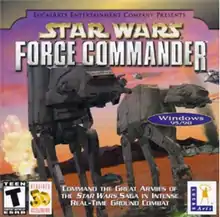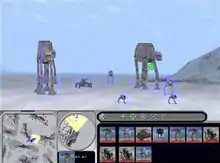Star Wars: Force Commander
Star Wars: Force Commander is a real-time strategy video game released for the Microsoft Windows platform on March 17, 2000. It was co-developed by Ronin Entertainment and LucasArts, and published by LucasArts. Its plot interweaves between Star Wars: A New Hope and Return of the Jedi, taking place in key battles. Peter McConnell created remixed tracks of John Williams's original score with influences from hard rock and techno music.
| Star Wars: Force Commander | |
|---|---|
 CD jewel case cover | |
| Developer(s) | LucasArts, Ronin Entertainment |
| Publisher(s) | LucasArts |
| Director(s) | Garry M. Gaber |
| Designer(s) | Garry M. Gaber |
| Programmer(s) | Edward Kilham |
| Artist(s) | Garry M. Gaber |
| Writer(s) | Garry M. Gaber |
| Composer(s) | Peter McConnell |
| Platform(s) | Microsoft Windows |
| Release | |
| Genre(s) | Real-time strategy |
| Mode(s) | Single-player, multiplayer |
Reception by critics was mixed, with aggregate website GameRankings reporting a 58.42% approval rating. Critics cited poor controls as a primary issue. Reviewers were divided on the quality of the game's visuals, with some calling them dated and others considering them strong. Gameplay was generally considered simpler than other real-time strategy games.
Gameplay

Star Wars: Force Commander is a real-time strategy video game. The player commands forces as though they are the commander rather than an infantry unit. The game utilizes a birds-eye view around a 3D map. The levels are largely plot-focused, with initial levels playing as the Imperial faction against the Rebellion, whilst as the plot progresses and the character defects to the Rebellion, players then fight against the Imperials. Levels are ground assault based, as the game lacks space combat. Outsides of the main story-mode Campaign, scenarios can be re-played under the Scenario option, and players can set up their own battles in the Skirmish mode where up to four sides can compete against one another, though they only have the faction choice of Imperials or the Rebellion.
The game has multiple networked multiplayer options. Up to six players can join together, and Local area network (LAN) and TCP/IP connections are supported. The game was supported by the defunct Microsoft Gaming Zone.[2][3][4] LAN gameplay is limited to two players. Multiplayer mode has an instant action mode but no campaign mode. Players can choose any combination of teams or work together to challenge the computer player.[5]
Plot
The game interweaves an original story between the events of Star Wars: A New Hope and Return of the Jedi, sometimes intersecting with known Star Wars events. It is shown from the point of view of a young officer in the Imperial Navy, Brenn Tantor, who begins as a stormtrooper, but soon enough is given his own command. The first task (from the training missions) is to search for an escape pod that landed on Tatooine, and then track the droids that were inside. This is a reference to the opening scenes of Episode IV when C-3PO and R2-D2 escape the Empire via an escape pod which crashes on Tatooine.
The main character is loyal to the Empire for the first half of the game, until his brother, Dellis Tantor discovers that the Empire killed their father. Dellis is imprisoned by the Empire for revealing this information, though Brenn is initially led to believe that Dellis has been killed. Brenn defects to the Rebel Alliance and proceeds to fight his former commanders. In addition to the Tatooine training missions, the player participates in the Battle of Hoth from the Imperial point of view, and the Battle of Endor as a Rebel. The game ends with the battle to capture the Imperial Palace on Coruscant, and ultimately the liberation of Dellis.
Development
Originally conceived as a 2D strategy game, LucasArts canceled the overall design after its first public viewing at E3 1998.[6] LucasArts instead used an optimized version of a 3D engine supplied by Ronin Entertainment,[7][8] delaying the game from its original late 1998 or early 1999 release timeframe to an early 2000 release. The company said it took the time to ensure innovation in this competitive genre on no exact deadline.[9] The game was jointly developed by LucasArts and Ronin Entertainment, using Ronin's programmers and engine partnered with LucasArts's project leadership, designers, and artists. The final patch for the game is version 1.1 released in March 2000. The soundtrack consists of hard rock and techno remixes of John Williams's original Star Wars scores, done by Peter McConnell.[10] More than 3,500 voice lines were recorded for the game.[11]
Reception
| Aggregator | Score |
|---|---|
| GameRankings | 58.42%[12] |
| Publication | Score |
|---|---|
| AllGame | |
| GamePro | |
| GameRevolution | D[14] |
| GameSpot | 6/10[15] |
| GameZone | 8/10[16] |
| IGN | 4.7/10[17] |
| Next Generation | |
| PC Gamer (US) | 43%[19] |
| PC Zone | 81%[20] |
| PC Gaming World | 7/10[21] |
Star Wars: Force Commander was met with very mixed reception. Greg Kasavin of GameSpot gave the game a 6 out of 10.[15] He cited dated graphics, ineffective controls, and flawed gameplay as reason the game "falls short of its ambitious intent".[15] Kasavin conceded the game "has some good ideas. Its campaign has an involving plot and interesting mission objectives", and praised the 3D mission briefings.[15] Mark Hill of PC Zone said that though playing from the perspective of the Galactic Empire was a "nice twist, but merely dumping this style of game into the Star Wars universe is not innovative enough."[20] Nick Woods of AllGame said that the game's 3D models were "blocky and not detailed" and added that there are "many other RTS games on the market better than this one".[13] Tal Blevins of IGN gave it a score of 4.7 out of 10.[17] In a feature on the history of Star Wars games, IGN's Rus McLaughlin called Force Commander "a blocky, buggy, undiluted failure".[22] A similar article in GMR Magazine from March 2004 listed Force Commander as the worst Star Wars game.[23] In the book Rogue Leaders: The Story of LucasArts, author Rob Smith said the "dated-looking visuals and clumsy controls turned off strategy gamers".[24] Hollywood.com placed it fifth in a list of worst Star Wars video games. The staff said that Force Commander had "an unwieldy camera and uninspired combat".[25] Rock, Paper, Shotgun's Alec Meer was also highly critical of the game. "I didn't make it past the first few levels. It was miserable."[26]
Chris Kramer reviewed the PC version of the game for Next Generation, rating it two stars out of five, and stated that "Another in a long string of Star Wars misses, Force Commander is not as bad as Rebellion, but isn't even as good as Myth II or Warzone 2100."[18]
In PC Gamer's article on the history of Star Wars games on PC, author Chris Thursten called Force Commander "ambitious but rough around the edges".[27] Craig Majaski of Gaming Age praised the game's easy learning curve, visuals and music. He praised the 3D presentation and said the models were "excellent", but noted that the camera often was difficult to control.[28] Michael Lafferty of GameZone said that, while enjoyable, Force Commander did not provide as much depth as other real-time strategy games, specifically mentioning the Command & Conquer series.[16] Electric Playground gave it a 7 out of 10.[12] A CNet reviewer said that the game requires genre novices to frequently reference the documentation, but noted that "Star Wars fans and intermediate-level gamers who like third-person views" would enjoy the game.[29] Soren Johnson, then a programmer at Maxis, berated the game's "infamously difficult" camera.[30] IGN Germany's Robert Hähnel listed Force Commander among his picks for Star Wars games he said deserved a sequel.[31]
References
- Staff (March 17, 2000). "News Briefs". IGN. Archived from the original on March 4, 2001. Retrieved May 4, 2020.
- McLeeven, Nick (April 19, 2000). "Force Commander review". CD Mag. Archived from the original on May 30, 2003. Retrieved April 10, 2017.
- Clarkson, Mark (May 9, 2000). "Forced Commander". Computer Gaming World. Archived from the original on February 11, 2001. Retrieved April 10, 2017.
- Donowitz, Leo (April 18, 2000). "Star Wars: Force Commander review". Game Over. Retrieved April 10, 2017.
- Wight, Brian (March 31, 2000). "Star Wars: Force Commander Review for PC on GamePro.com". GamePro. Archived from the original on February 19, 2005. Retrieved August 24, 2014.
- "Star Wars Force Commander trailer". LucasArts. 1998. Retrieved March 15, 2017.
- IGN staff (November 10, 1999). "Star Wars: Force Commander". IGN. Retrieved April 10, 2017.
- Blevins, Tal (November 9, 1999). "Star Wars: Force Commander Preview". IGN. Archived from the original on April 17, 2001. Retrieved May 4, 2020.
- Staff (October 1, 1998). "Force Commander Forced Back". IGN. Archived from the original on June 9, 2001. Retrieved May 4, 2020.
- From Italian fan-site Lucasdelirium, its section "Biographies" (folder of Peter McConnell): "His masterpieces come in the last two years of his career as Lucasian: the incredible soundtrack of the wonderful Grim Fandango, steeped in jazz, swing and bizarre Danny Elfman (the composer for Tim Burton), as well as rearrangements in key hard-rock / techno style of John Williams's music for the Star Wars saga, for RTS Star Wars: Force Commander."
- "Star Wars at Your Command". StarWars.com. March 6, 2000. Archived from the original on May 17, 2008. Retrieved April 10, 2017.
- "Star Wars: Force Commander for PC". GameRankings. Retrieved March 5, 2013.
- Woods, Nick. "Star Wars: Force Commander - Review". AllGame. Retrieved March 5, 2013.
- Johnny B (April 2000). "Star Wars: Force Commander Review". Game Revolution. Retrieved August 24, 2014.
- Kasavin, Greg (March 24, 2000). "Star Wars: Force Commander Review". GameSpot. Retrieved August 24, 2014.
- Lafferty, Michael (March 27, 2000). "Star Wars Force Commander Review - PC". GameZone. Archived from the original on October 7, 2007. Retrieved August 24, 2014.
- Blevins, Tal (March 24, 2000). "Star Wars: Force Commander". IGN. Retrieved August 24, 2014.
- Kramer, Chris (June 2000). "Finals". Next Generation. Vol. 3 no. 6. Imagine Media. p. 103.
- Poole, Stephen (August 2000). "Star Wars: Force Commander". PC Gamer. Archived from the original on September 22, 2004. Retrieved August 24, 2014.
- Hill, Mark (2000). "PC Review: Star Wars: Force Commander". PC Zone. Archived from the original on June 24, 2007. Retrieved August 24, 2014.
- Marsh, Ian (April 28, 2000). "Star Wars: Force Commander Review". PC Gaming World. Archived from the original on September 30, 2000.
- McLaughlin, Rus (September 10, 2008). "IGN Presents the History of Star Wars Games". IGN. Retrieved March 5, 2013.
- GMR. March 2004
- Smith, Rob (2008). Rogue Leaders: The Story of LucasArts. Chronicle Books. ISBN 978-0-8118-6184-7.
- Hollywood.com Staff (April 2013). "Farewell, LucasArts: The 10 Best 'Star Wars' Videogames". Hollywood.com. Retrieved April 1, 2017.
- Meer, Alex (May 4, 2016). "Have You Played ... Star Wars: Force Commander?". Rock, Paper, Shotgun. Retrieved March 15, 2017.
- Thursten, Chris (November 17, 2015). "The complete history of Star Wars on PC". PC Gamer. Retrieved April 1, 2017.
- Majaski, Craig (May 22, 2011). "Gaming Age Review - Star Wars Force Commander". Gaming Age. Archived from the original on May 22, 2001. Retrieved April 1, 2017.CS1 maint: bot: original URL status unknown (link)
- Download.com staff (February 27, 2009). "Editors' Review". CNet. Retrieved April 10, 2017.
- Johnson, Soren (November 21, 2008). "Analysis: The Quandary Of 2D Vs. 3D". Gamasutra. Retrieved April 10, 2017.
- Hähnel, Robert (April 4, 2013). "Die zehn besten nächsten Spiele von LucasArts". IGN. Retrieved April 10, 2017.
External links
- Official website via the Wayback Machine
- Star Wars: Force Commander at MobyGames
- Star Wars: Force Commander on Wookieepedia, a Star Wars wiki